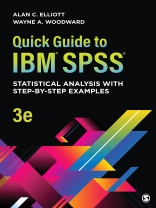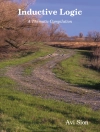A perfect supplement for an introductory statics course.
Quick Guide to IBM® SPSS®: Statistical Analysis With Step-by-Step Examples gives students the extra guidance with SPSS they need without taking up valuable in-class time. A practical, accessible guide for using software while doing data analysis in the social sciences, students can learn SPSS on their own, allowing instructors to focus on the concepts and calculations in their lectures, rather than SPSS tutorials. Designed to work across disciplines, the authors have provided a number of SPSS ‘step-by-step’ examples in chapters showing the user how to plan a study, prepare data for analysis, perform the analysis and interpret the output from SPSS.
The new Third Edition covers IBM® SPSS® version 25, includes a new section on Syntax, and all chapters have been updated to reflect current menu options along with many SPSS screenshots, making the process much simpler for the user. In addition, helpful hints and insights are provided through the features ‘Tips and Caveats’ and ‘Sidebars.’
Зміст
Preface & Acknowledgments
About the Authors
Chapter 1 • Introduction
Getting the Most Out of Quick Guide to IBM SPSS
A Brief Overview of the Statistical Process
Understanding Hypothesis Testing, Power, and Sample Size
Understanding the p-Value
Planning a Successful Analysis
Guidelines for Creating Data Sets
Preparing Excel Data for Import
Guidelines for Reporting Results
Downloading Sample SPSS Data Files
Opening Data Files for Examples
Summary
References
Chapter 2 • Describing and Examining Data
Example Data Files
Describing Quantitative Data
Describing Categorical Data
Summary
References
Chapter 3 • Creating and Using Graphs
Introduction to SPSS Graphs
Guidelines for Creating and Using Graphs
Chart Builder
Graphboard Template Chooser
Legacy Plots
Scatterplots
Histograms
Bar Charts
Pie Charts
Boxplots
Summary
References
Chapter 4 • Comparing One or Two Means Using the t-Test
One-Sample t-Test
Two-Sample t-Test
Paired t-Test
Summary
References
Chapter 5 • Correlation and Regression
Correlation Analysis
Simple Linear Regression
Multiple Linear Regression
Summary
References
Chapter 6 • Analysis of Categorical Data
Contingency Table Analysis (r × c)
Contingency Table Examples
Mc Nemar’s Test
Mantel-Haenszel Meta-Analysis Comparison
Tests of Interrater Reliability
Goodness-of-Fit Test
Other Measures of Association for Categorical Data
Summary
References
Chapter 7 • Analysis of Variance and Covariance
One-Way ANOVA
Two-Way Analysis of Variance
Repeated-Measures Analysis of Variance
Analysis of Covariance
Summary
References
Chapter 8 • Nonparametric Analysis Procedures
Spearman’s Rho
Mann-Whitney-Wilcoxon (Two Independent Groups Test)
Kruskal-Wallis Test
Sign Test and Wilcoxon Signed-Rank Test for Matched Pairs
Friedman’s Test
Summary
Reference
Chapter 9 • Logistic Regression
Appropriate Applications for Logistic Regression
Simple Logistic Regression
Multiple Logistic Regression
Summary
References
Appendix A: A Brief Tutorial for Using IBM SPSS for Windows
Appendix B: Choosing the Right Procedure to Use
Index
Про автора
Wayne A. Woodward, Ph.D., is a Professor of Statistics and chair of the Department of Statistical Science at Southern Methodist University. He is a fellow of the American Statistical Association and was the 2004 recipient of the Don Owen award for excellence in research, statistical consulting, and service to the statistical community. In 2007 he received the Outstanding Presentation Award given by the Section on Physical and Engineering Sciences at the 2007 Joint Statistical Meetings in Salt Lake City, Utah. In 2003 he was named a Southern Methodist University Distinguished Teaching Professor by the university’s Center for Teaching Excellence, and he received the 2006-2007 Scholar/Teacher of the Year Award at SMU, an award given by the United Methodist Church. . Over the last 35 years he has served as statistical consultant to a wide variety of clients in the scientific community and has taught statistics courses ranging from introductory undergraduate statistics courses to graduate courses within the Ph.D. program in Statistics at Southern Methodist University. He has been funded on numerous research grants and contracts from government and industry to study such issues as global warming and nuclear monitoring. He has authored or coauthored over 70 scientific papers and four books.












